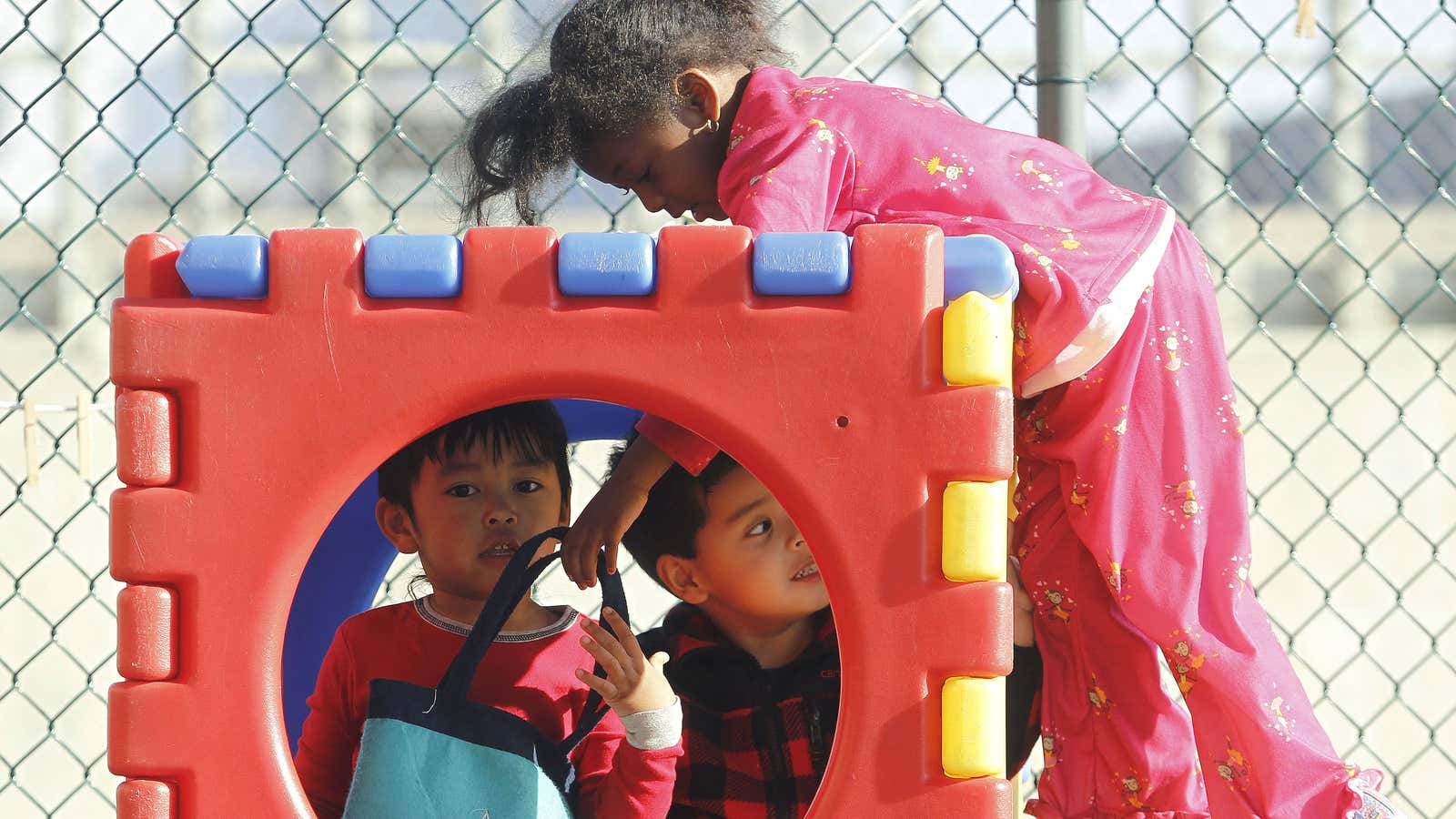Considerable research shows that well-designed early childhood programs can help children, particularly those who are disadvantaged, build social, emotional and academic skills that can help them as students and in life.
The US seems to have missed that memo.
In 2014, it had one of the lowest enrollment rates for children in early childhood and pre-primary programs among the world’s richest 35 countries. Only three do worse than the US at offering programs for kids aged three and four: Turkey, Switzerland and Greece. In the US only 42% of three-year olds and 68% of four-year olds were enrolled; among countries in the Organization for Economic Cooperation the average is is 71% and 86%, respectively.
“We value our children less than other nations do,” Arne Duncan, the former U.S. secretary of education told the Hechinger report, which recently published a five-part series on public preschools. “I don’t have an easier or softer or kinder way to say that.”
Why it matters
The first few years of a child’s life are critical for building their adult success. “Serve and return,” the process by which adults engage with babies by making eye contact, smiling, talking and teaching them provide the basis for building communication and healthy relationships. Reading to kids, singing to them and having conversations builds literacy and language. Play helps kids socialize, develop motor skills and learn to be part of a group; dressing up and making up silly games engages kids’ impressive imaginations. Even learning to put on a coat–through methods like “flip, flop, over the top” teach kids independence and agency.
Home is the first, and most important place to help kids learn and grow. But most parents work, making affordable childcare solutions critical, especially for poorer families where stress levels can be high and access to early childhood programs (pdf) to help mitigate the dangerous effects of that stress is notoriously low.
It’s possible
Britain figured this out in 2004, when parliament reviewed the research on the benefits of early childhood programs. When UK researchers presented data that tracked 3,000 children from the mid-1990s through 2008, “only one conclusion could be drawn” the Hechinger report wrote: “The government should pay for preschool for all three-year-olds.”
The government now pays for any child in England who has turned three by Sept. 1 to have 15 hours a week of free child-care or preschool for 38 weeks a year, or 570 hours total. Children start school at age four, in what the UK calls reception, which is like pre-kindergarten. In other words, all four-year-olds have state-funded schooling. In 2014, 84% of three-year-olds were enrolled in an early childhood program and 99% of four-year olds were in reception.
Having subsidized childcare has significant ripple effects, including helping women balance work and home life. In 1981, only 24% of British women returned to work within a year of childbirth; by 2014 76% of women were back to work within 18 months after giving birth, according to the Department for Work and Pensions.
The children benefitted too: According to the Hechinger report, the share of children achieving “good development” has increased since the introduction of free preschool 12 years ago, and the achievement gap between rich and poor has narrowed, albeit only slightly.
But it’s not happening in the US
Compare that to the US, one of the few developing countries where women are returning to work at increasingly lower rates a year after giving birth. That rate peaked in 1999 at 74%; in 2014 it was 69%. According to a study from the National Bureau of Economic Research, nearly a third of the relative decline in women’s return to work is because the US has worse family and child care policies than many European countries.
Childcare options in the US vary greatly in quality, and in cost. According to the First Five Years Fund, which lobbies for investment in early childhood, less than half of low-income children have access to the kind of high-quality early childhood programs which research shows result in better health, education and employment later in life.
Head Start, a federal program, aids kids in poverty, but it does not help all low, or middle-income families, the majority of whom spend more than 10% of their household income on childcare, according to a report from Care.com. One-fifth spend 20%. One study found that in 23 states full-time preschool for four-year-olds was more expensive that in-state public college tuition.
The evidence is not uniformly in favor of preschool. Some research shows that kids who attend preschool do better academically, but suffer socially, showing more signs of aggression and behavioral problems. Others argue that the benefits of preschool fade.
Quality clearly matters, as does design: Young children need constant access to a secure attachment figure, and care centers that are not chaotic. Also, it is more developmentally appropriate for kids to play than to face a barrage of flash cards or reading tests.
But preschools can be designed that way, because many already are, with make-believe corners, reading nooks, blocks, paints and circle time. Training early childhood care providers and paying them better would help, as would federal standards that emphasize safe play rather than tougher academic standards.
Things may be improving. Cities including New York and Denver, Colorado now offer universal preschool, and in a rare show of bipartisan support, Congress increased federal spending on early childhood by about $1 billion last fiscal year, a pattern that has been continuing for a few years.
But closing the gap with other industrialized countries will require much more money as well as agreement on what to do.
It will also require time. Steven Barnett, director the National Institute for Early Education Research, estimates it will take 150 years (pdf) to have programs in place for 75% of all four-year-olds.
That’s a lot of years to crawl back from nearly last place.
